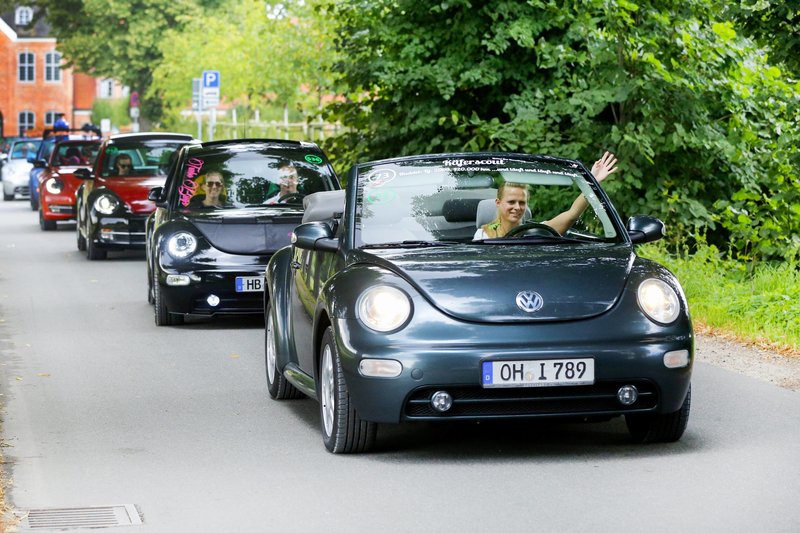美国前官员揭德企黑历史

2016年8月20日,第12届“甲壳虫阳光行”车聚派对在德国吕贝克的特拉弗明德举行,图为活动上的甲壳虫汽车。
Franziska Krug—Getty Images for Beetle Sunshine
|
10只看动画片的长尾猕猴,与柴油车的安全性有什么关系? 本来没什么关系。不过如果你看过Netflix最近出品的纪录片《脏钱》,你会就会知道,2014年在美国新墨西哥州阿尔伯克基市郊区的一座实验室里,这些猴子挤在一间封闭的小隔间中,而一辆大众甲壳虫轿车的尾气直接排在猴子们所处的小隔间里。这次实验是由一个名叫欧洲运输业环境与健康研究会(EUGT)的德国汽车行业机构出资赞助的。 拿猴子作实验并不是最令人气愤之处。由于在软件上作了弊,这辆甲壳虫的尾气有毒物质含量实际上超标了40倍。一系列测试结果证明,这辆大众甲壳虫的污染水平比一辆1997年产的老款福特皮卡还厉害,有关公司因此决定不对外公布测试结果。 这次猴子实验是在阿尔伯克基市的洛克莱斯呼吸病研究所进行的,EUGT是此次实验的赞助商。实验目的是要拿出或者说捏造出“科研成果”,证明新技术已经使柴油变得安全了。而EUGT的所有拨款都来自大众、戴姆勒和宝马。由于它的工作备受争议,这家机构也于去年关停。 要想在柴油问题上拿出有利于汽车行业的数据,当然是非常不容易的。欧洲之所以在90年代大搞柴油车,是因为柴油车排放的温室气体要少于同类的汽油车。但是等到了“猴子实验”的时候,柴油车的负面影响已经吸引了越来越多人的关注。 欧洲议会发布的一份报告显示,2012年,欧洲有72,000人因二氧化氮污染而早逝。有些欧洲城市已经划设了限制或禁止柴油车通行的区域。上月德国最高联邦法院也出台了一项重要规定,宣布各个城市有权自行决定禁止柴油车上路。而在上书请愿禁止柴油车的城市中,奔驰和保时捷的老家——斯图加特也赫然在列。 大众等德国汽车公司都想通过所谓的“科研成果”刺激柴油车在美国的销量。不过在经历了“柴油门”和2015年的大众汽车排放测试作弊事件后,德国厂商的“柴油热”也彻底凉了下来,那次作弊事件也导致大众蒙受了300多亿美元的损失。 当我听说这些测试时,我首先想到了我在美国环境保护署工作的这32年多的经历。当年我在担任环保署辐射与室内空气处主任时,我们发布了第一份关于吸二手烟的危害的报告。结果我们的报告遭到了烟草行业的激烈反对,他们马上搞了一系列有误导性的科学试验来混淆视听,妄图让老百姓罔顾吸烟的安全风险。为了证明他们的产品是安全的,不少烟草公司也在一系列动物身上搞了非常类似的实验。 跟吸烟不同的是,柴油引擎对我们还是有益处的,它在全球货运体系中扮演了不可或缺的角色,另外柴油也不是不能做得更清洁些。后来在我担任环保署交通空气质量处主任期间,我掀起了一场后来所谓的“清洁柴油”运动。2000年重型柴油机规定出台后,我们围绕清洁柴油燃料采取了一些监管行动,将有毒柴油机废气减少了95%。 重型柴油机规定出台后,我们估计平均每年避免了8300人的早逝,使75万人免于遭受呼吸系统疾病的侵袭。美国健康影响研究所近期研究表明,现代柴油发动机的尾气毒性已远低于以前的高污染柴油引擎。但是,所谓的“清洁柴油”也并不是完全清洁的。 关于这个问题,汽车业的一个通病就是作弊成风,同时对标准不能一以贯之地执行。我在交通空气质量处当主任的18年间处罚过的汽车厂商、柴油发动机厂商和卡车制造商中,有的甚至里用高污梁产品作弊长达10年以上。就在上个月,梅赛德斯奔驰还曝出了作弊事件。另外,从美国环保署现任署长斯科特•普瑞特最近的一些行动上也不难看到金钱和政治的影子。环保署最近向高污梁柴油卡车开了绿灯,就是在他的授意下做的决定。 那么,我们怎样才能让柴油发动机变得彻底安全呢?现实地说,根本做不到。在我们所知的范围内,只有一个持续有效的战略能解决柴油对人体健康和气候变化的影响,那就是推动整个运输体系电动化。电动汽车不排放尾气,也能缓解气候变化带来的影响。 有人称,随着电动汽车的发展,电燃引擎汽车剩下的日子已经不多了。对于轻型车辆或许如此,但对于中型特别是重型车辆来说,在电动汽车的技术和基础设施平价化、普遍化之前,柴油可能还得继续扮演一定的角色。 在乘用车持续电动化的同时,我们也不能放松对柴油技术的关注。我们要继续推动柴油发动机技术的进步,特别是要认真执行相关规定,确保降低柴油机对健康的影响,同时将它对环境的影响降至最低。 不过要达到这个目标,并不需要汽车公司给猴子灌尾气做实验。(财富中文网) 本文作者Margo Oge曾在美国环境保护署工作32年,曾于1994年至2012年间任美国环保署交通与空气质量处主任,她也是美国2025 GHG/CAFÉ标准的主要起草者。她也是《驾驭未来:用清洁智能汽车对抗气候变化》一书的作者。 译者:朴成奎 |
What do 10 long-tailed macaque monkeys watching cartoons have to do with making diesel safer? Ideally nothing, but if you watched the recent Netflix documentary Dirty Money, you would see a lab outside of Albuquerque in 2014, where these primates are sitting in air-tight compartments while a Volkswagen Beetle’s diesel fumes are pumped inside. It was as part of an experiment paid for by the European Research Group on Environment and Health in the Transport Sector (EUGT), a German auto industry group. But it’s actually worse than all that. The Beetle was 40 times the legal limit due to software that cheated the system. The tests proved that the VW car was polluting morethan an old, 1997-year Ford truck, and the companies decided not to publicly release the test results. The monkey experiment, conducted at the Lovelace Respiratory Research Institute in Albuquerque, was sponsored by EUGT. The goal was to create (bogus) scientific research proving that new technology had made diesel safe. EUGT received all of its funding from Volkswagen, Daimler, and BMW. It shut down last year amid controversy over its work. There was a lot at stake for the companies to produce industry-friendly data. Europe embraced diesel in the 1990s because, on average, diesel cars and trucks produce fewer greenhouse gases than similar gasoline vehicles. But, by the time of the monkey experiments, the negative health effects of diesel were getting more attention. A report released by the European Parliament showed that 72,000 people in Europe died prematurely because of nitrogen dioxide pollution in 2012. Some European cities are creating zones that restrict diesel vehicles, or banning them outright. In Germany, the highest federal court issued a landmark ruling last month that cities have the right to ban diesel cars. One of those cities petitioning the court for a ban was Stuttgart, the home of Mercedes and Porsche. Volkswagen, along with the other German auto companies, also wanted to use the research to increase their diesel sales in the United States. That came to a screeching halt with “Dieselgate” and VW’s emissions cheating scheme in 2015, which has cost the company more than $30 billion. When I learned about these tests, my mind immediately flashed back to events in my 32-plus year career with the U.S. Environmental Protection Agency. First, it was the time I was the director of the Office of Radiation and Indoor Air (ORIA), where we developed the first report about the dangers of secondhand smoke. Our report got massive pushback from the tobacco industry, which created a variety of misleading research designed to confuse the public about the massive health risks of their products. Cigarette companies had, in fact, run very similar tests on a variety of animals to prove that their products were safe. But unlike smoking, diesel engines serve a purpose, are an integral part of the freight transportation systems of the world, and can be made cleaner. Later in my EPA career, as director of the Office of Transportation Air Quality (OTAQ), I led the effort that ended up becoming known as “clean diesel.” With the Heavy Duty Diesel rule in 2000, we took regulatory action to clean diesel fuel and reduce toxic diesel exhaust by 95%. As a result of this rule, 8,300 premature deaths and 750,000 respiratory illnesses were expected to be prevented annually. Recent studies by the Health Effects Institute concluded that the overall toxicity of modern diesel engines are significantly lower than the high-polluting older engines, but even “clean diesel” is not perfectly clean. What exacerbates the situation today is endemic cheating and the lack of consistent enforcement of the standards. In my 18 years as director of OTAQ, we had fined car manufacturers and diesel engine and truck companies that were cheating with polluting trucks for over a decade. Just last month, new revelations emerged about alleged cheating by Mercedes Benz. And, there is money and politics as witnessed in the recent actions of Scott Pruitt, the current EPA administrator, who is behind a decision to give compliance waiver to the highly polluting diesel truck “glider kits.” So, how can we make diesel engines completely safe? Realistically, we can’t. There is only one known, long-lasting strategy to address both human health and climate change: move to electrification of our transportation system. Electric vehicles have no emissions and help mitigate the environmental challenge of our time: climate change. Some say the internal combustion engine’s days are numbered, and that may be true for light-duty vehicles nearing the “tipping point” for electric vehicles. But in medium-duty and especially heavy-duty vehicles, diesel will continue to play a role as we wait for technologies and infrastructure to become more economically feasible. While the passenger vehicle sector is getting electrified, we cannot take our eye off diesel technology. It will be important to continue improvements to diesel engines—and especially enforcement of the rules—to ensure that their health effects continue to be reduced and their contribution to climate change is minimized. But that doesn’t require industry studies of gassed monkeys. Margo Oge served the United States Environmental Protection Agency for over 32 years and most recently, was the director of the EPA’s Office of Transportation and Air Quality (OTAQ) from 1994 to 2012 and a key architect of the 2025 GHG/CAFE Standards. She is also the author of the book, Driving the Future: Combating Climate Change with Cleaner, Smarter Cars. |













